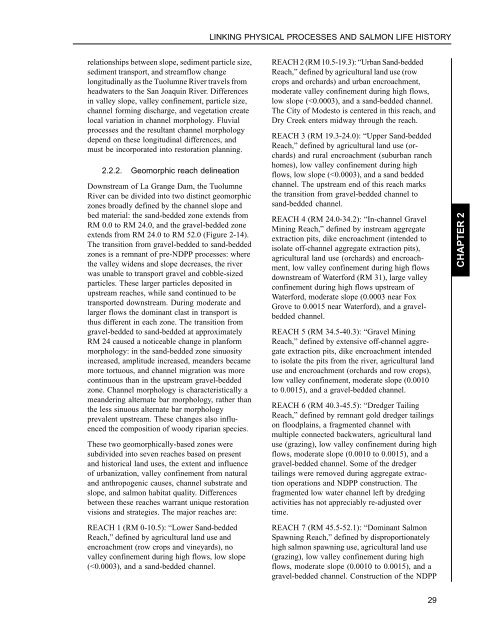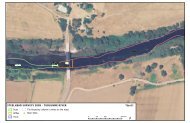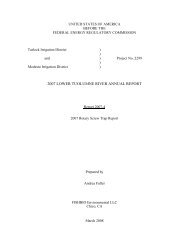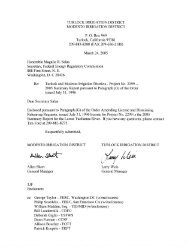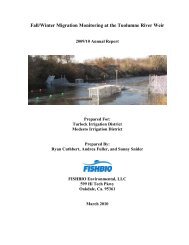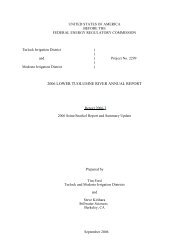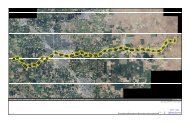Tuolumne River Report - U.S. Fish and Wildlife Service
Tuolumne River Report - U.S. Fish and Wildlife Service
Tuolumne River Report - U.S. Fish and Wildlife Service
You also want an ePaper? Increase the reach of your titles
YUMPU automatically turns print PDFs into web optimized ePapers that Google loves.
LINKING PHYSICAL PROCESSES AND SALMON LIFE HISTORYrelationships between slope, sediment particle size,sediment transport, <strong>and</strong> streamflow changelongitudinally as the <strong>Tuolumne</strong> <strong>River</strong> travels fromheadwaters to the San Joaquin <strong>River</strong>. Differencesin valley slope, valley confinement, particle size,channel forming discharge, <strong>and</strong> vegetation createlocal variation in channel morphology. Fluvialprocesses <strong>and</strong> the resultant channel morphologydepend on these longitudinal differences, <strong>and</strong>must be incorporated into restoration planning.2.2.2. Geomorphic reach delineationDownstream of La Grange Dam, the <strong>Tuolumne</strong><strong>River</strong> can be divided into two distinct geomorphiczones broadly defined by the channel slope <strong>and</strong>bed material: the s<strong>and</strong>-bedded zone extends fromRM 0.0 to RM 24.0, <strong>and</strong> the gravel-bedded zoneextends from RM 24.0 to RM 52.0 (Figure 2-14).The transition from gravel-bedded to s<strong>and</strong>-beddedzones is a remnant of pre-NDPP processes: wherethe valley widens <strong>and</strong> slope decreases, the riverwas unable to transport gravel <strong>and</strong> cobble-sizedparticles. These larger particles deposited inupstream reaches, while s<strong>and</strong> continued to betransported downstream. During moderate <strong>and</strong>larger flows the dominant clast in transport isthus different in each zone. The transition fromgravel-bedded to s<strong>and</strong>-bedded at approximatelyRM 24 caused a noticeable change in planformmorphology: in the s<strong>and</strong>-bedded zone sinuosityincreased, amplitude increased, me<strong>and</strong>ers becamemore tortuous, <strong>and</strong> channel migration was morecontinuous than in the upstream gravel-beddedzone. Channel morphology is characteristically ame<strong>and</strong>ering alternate bar morphology, rather thanthe less sinuous alternate bar morphologyprevalent upstream. These changes also influencedthe composition of woody riparian species.These two geomorphically-based zones weresubdivided into seven reaches based on present<strong>and</strong> historical l<strong>and</strong> uses, the extent <strong>and</strong> influenceof urbanization, valley confinement from natural<strong>and</strong> anthropogenic causes, channel substrate <strong>and</strong>slope, <strong>and</strong> salmon habitat quality. Differencesbetween these reaches warrant unique restorationvisions <strong>and</strong> strategies. The major reaches are:REACH 1 (RM 0-10.5): “Lower S<strong>and</strong>-beddedReach,” defined by agricultural l<strong>and</strong> use <strong>and</strong>encroachment (row crops <strong>and</strong> vineyards), novalley confinement during high flows, low slope(


